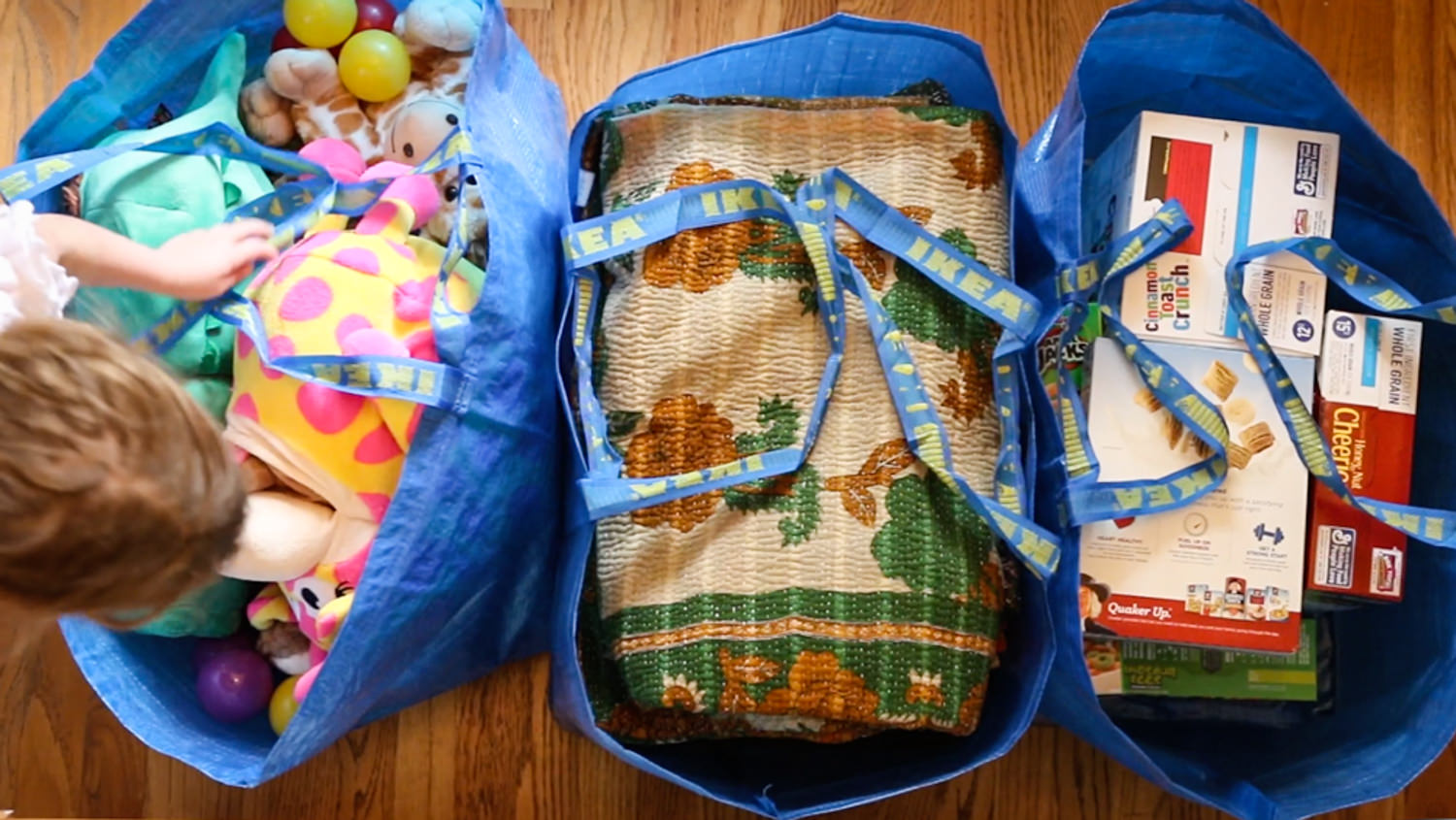Jump Ahead To:
How to Pack For a Move: Moving and Packing Tips
So, you’re wondering how to pack for a move–without going crazy. We don’t blame you. Packing for a move—going through all the items you own, packing all those boxes and labeling them, packing every room of your house—can be intimidating.
Packing for a weekend away can feel stressful, and packing for a long vacation can be overwhelming. Packing up everything you own and moving it to a new house? That’s a move that can be downright panic-attack-inducing. Moving stress is a real thing.
But, do us a favor: take four deep breaths, and try to relax. Whether it’s your first or 20th move, you can use our tips and checklist below to make packing for your move and getting settled into your new home as simple and stress-free as possible.
Because we’re movers, we have a LOT of packing guides. Check out our various packing guides below:
12 packing hacks to get you packed in three days or less
How to pack liquor and wine bottles
8 things that are cheaper to replace than to pack
How to pack fine china for moving
How to pack silverware for moving
How to pack pots & pans for a long-distance move
What and how to pack your first college dorm

How to make packing for a move easier: 7 simple tips
In this section, we are going to show you how to make packing and moving happen without a hitch. We have broken the packing process down into seven easy-to-follow tips.
Please keep in mind that while we recommend this process, there is no “perfect” way to pack. So, do what is most comfortable for you while packing. These are just the steps we have found that made the packing and moving process the simplest for our 100,000+ customers.
#1: Pack every item you haven’t used in the past year, and sell it
For most people, parting with belongings is the hardest part of the moving process. But, if you haven’t worn a pair of shoes in the past 365 days, are you ever going to wear them? Not likely. Pack those babies up, and sell them.
A big move is a perfect opportunity to get rid of those things you never use while putting some extra cash in your pocket. Try selling items on Craigslist or LetGo. You can also pack it all up in boxes, and drop it off at your local thrift store.
#2: Donate everything you can’t sell
When you choose to let go of your old belongings, you are not only making it easier for yourself, but you are also making it easier for someone else. If you don’t want to sell the things you don’t use anymore, why not just give them away to someone who is less fortunate? This is a simple way to help others.
#3: Organize all of your belongings into specific categories
This is a relatively simple step. Pack kitchen supplies with kitchen supplies. Pack cleaning supplies with cleaning supplies. Pack books with books. So on and so forth.
When you start mixing and matching your belongings, you’re going to run into some trouble after moving. While throwing everything you own into a box may be easier, it makes it more difficult to unpack. Your future self will thank your past self if you take the time to pack thoughtfully.
#4: As you’re packing, label your boxes
Invest in a fat Sharpie, and label each and every box you pack. It might be tempting to leave this step out, but we promise that it’s worth your time.
When you are moving into your new home, this will make it easier for your movers to take your boxes to exactly where they need to be. And one more tip? Label the boxes as you pack them. Don’t wait until the end!
If you’re interested in a more bespoke experience, our partner Stachd offers QR code labels that enable you to easily categorize and inventory your box contents.
#5: Take care of all the little things
There are several little things that people overlook when in the midst of packing for a big move.
Kitchen Packing Tips
Don’t purchase groceries during the week or so leading up to the big move. If so, you’ll throw away a lot of food that won’t survive the trip. Also, remember to defrost your fridge a few days before moving out.
Bathroom Packing Tips
Remember to pack all of your toiletries in Ziplocs or bags. You don’t want to unpack your boxes only to find a gooey shampoo explosion.
#6: Book movers—Bellhop, perhaps?
We recommend you hire a professional moving company, whether or not that is us. While your cousin’s friend’s brother’s truck is great, there is an art to moving your belongings from point A to point B in one solid piece.
It might be a little cheaper at first to pack and move on your own, but in the long run, it could cost you more money than you might realize. How many pickup trucks will it take you to move? How many gallons of gas is that? Do you actually enjoy being one of the movers?
The bottom line, really, though, is that packing is enough work already. You want to be able to relax on moving day. Work with professional movers, and you won’t regret it. Bellhop offers packing services along with local and long-distance moves, to make your life easier.
#7: Finish up well in advance
Earlier, we discussed how we as humans tend to be horrible procrastinators. We push off what we don’t want to do until the very last second. Most moving stress stems from individuals not being prepared for a move.
We recommend you start packing at least three weeks prior to your move. Just force yourself to pack for 30 minutes per night. That way, you can slowly chip away at the workload.

What to prioritize when packing
So, you might be saying, “That’s great. You gave me a nice, seven-step checklist. Some nice tips even. But what do I tackle first? I have a whole home full of stuff here!”
And believe us, we get it. (We are in the moving business, after all.) Standing there, looking around at your books, your TV, your clothes, your pots, your pans, and all of the other items in your home—it’s overwhelming. So, when you’re packing your life into boxes to move, here’s where to start:
The “low-hanging fruit”
The low-hanging fruit principle states that, essentially, when you have a long, complicated task in front of you (like packing up everything you own), start with the easy, straightforward things first. This is a simple way to avoid getting overwhelmed. Basically, pack the easiest boxes before you do anything else.
How to identify “easy” tasks
First, make a list of each room in your home. Think about packing your house room by room. If you think about packing everything in the whole home at once, we guarantee you’ll get stressed out.
Instead, think about each room, and break down packing the items in each room into smaller categories. For example, the categories in your living room might include the following: books, entertainment equipment and accessories, decorations, and furniture.
Once you have your list of rooms and the categories of items in each room, find the smallest, simplest category. Begin there.
When you’re working on this task, it might be tempting to try to work on other tasks at the same time, or maybe you’ll get stressed out and start thinking about all the other packing you have to do.
If that’s the case, we have a motto for your move: “task at hand.” Repeat it to yourself over and over. You can only pack your whole home by packing one thing at a time, and you’ll pack each thing a lot faster if you focus all your energy on it. One thing at a time.
Pack like a pro
We wanted to dedicate an entire section to packing moving boxes because it’s important for a stress-free day. The first piece of advice we will give when it comes to organizing moving boxes is this: pack heavy belongings in smaller boxes (ideally boxes that have handles).
It is much easier to pick up a small, 50-pound box than a large one. Large boxes tend to be awkward to carry and difficult to arrange in a moving truck.
When packing boxes for your move, never risk it
If you need to pack a valuable item that you are worried about damaging, don’t give it a second thought. Protect it. Put bubble wrap, blankets, or packing paper around it to protect it from the hustle and bustle. And, a quick side note: pack your dishes vertically. It reduces the risk of them breaking.
Lastly, don’t try to overstuff moving boxes. Cramming and overloading boxes with belongings can lead to damaged items and increase the risk of the box ripping. That would be bad news. So, remember that 25 items packed into a box are much easier for movers to move than 25 items scrambled all over the grass.
You have all of the tips you need to pack
Awesome. Now you should have a good idea of how to pack for a move. You’ll be ready for the big day before you know it! If you’re still feeling like you need some packing or move day guidance, check out our moving checklist. It covers every single thing to do before you move.
We are going to leave you with one final piece of advice that we mentioned once earlier: start packing two, three, or even four weeks in advance. We can’t stress enough how important it is to begin to pack earlier rather than later. The most stressful part of a move is scrambling around at the last minute to take care of everything that needs to get done.
As long as you have your boxes packed and ready, the toughest part of your move is over. Unpacking is the easiest and most exciting part—setting up your new life in a brand-new home.
Lastly, when you’re ready to book your movers, here is a quick blog with a few tips on comparing moving company quotes. And of course, you can always give us a ring!
- How Much Do Movers Cost? Moving Company Costs Explained. (Updated 2024) - July 9, 2024
- How to Pack for a Move in Three Days (Or Less!) - July 9, 2024
- How to Pack for a Move (Without Going Crazy) - June 26, 2024



